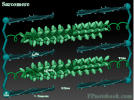Muscle Tissue, Muscle Contraction, Muscle Cell, Neuromuscular System, Neuromuscular Junction, Muscle Stretch Receptor, Muscle Spindle, Muscle Spindle Primary Nerve Ending, Muscle spindle Secondary Nerve Ending, Golgi Tendon Organ Nerve Ending, Neurotendinous Spindle, Golgi Tendon Organ, Muscle, Myocyte, Striated Muscle, Skeletal Muscle Cell, Striated Muscle Cell, Skeletal Myocyte, Smooth Muscle, Smooth Muscle Cell, Smooth Myocyte, Sarcolemma, Myofibril, Myofilament, Actin Myofilament, Myosin Myofilament, Sarcomere, Sarcoplasmic Reticulum, A band, H zone, I band, M line, Z line, Z Disc
- Physiology
- Neuromuscular - Sensory
- Sensory feedback is critical to maintaining continuous fluid movement that balances various motor Neuron inputs
- Golgi Tendon Organs (Neurotendinous Spindle)
- Detect Muscle tendon tension
- Measures combination of Muscle Contraction against the resistance of opposing forces (gravity, Antagonist Muscles)
- Triggers a reduction in Muscle tension by allowing further Muscle stretch
- Muscle Spindles
- Wrap intrafusal Muscle fibers
- Small Muscle fibers primarily for stretch detection
- Intrafusal Muscle fibers are innervated by gamma Motor Neurons
- Contrast with the extrafusal Muscle fibers, the primary, major Muscle fibers of motor activity
- Extrafusal Muscle fibers are innervated by alpha Motor Neurons
- Alpha and gamma Neurons typically fire together, keeping extrafusal and intrafusal Muscles in sync
- Small Muscle fibers primarily for stretch detection
- Detect Muscle stretch (and the speed of Muscle stretch)
- Transmit stretch Sensation to the spinal cord and Cerebellum
- Increased detected Muscle stretch drives increased counter Muscle Contraction
- Rapidly increased stretch, results in stronger signaling for Muscle Contraction
- Deep Tendon Reflexes generate a rapid stretch impulse with an exaggerated Muscle Contraction
- Primary nerve endings (Type 1A, Annulospiral)
- Detect degree and rate of Muscle stretch
- Secondary nerve endings (Type 2)
- Detect degree of Muscle stretch
- Wrap intrafusal Muscle fibers
- Other sensory input
- Joint capsule and ligament receptors
- Physiology
- Neuromuscular - Motor and Muscle Contraction
-
Antagonistic Muscles are inhibited during Muscle Contraction
- Triceps Muscle is inhibited during biceps flexion
- Hamstring Muscles are inhibited during quadriceps flexion
- Striated Muscle
- Muscle Cells or Fibers are composed of hundreds of Myofibrils
- Myofibrils are divided into repeated sections of Sarcomeres
- Sarcomeres are composed of overlapping myosin filaments and actin filaments

- Each Sarcomere is bordered by a Z-Disc on each end
- Actin filaments are attached to each Z-Disc
- Actin filaments do not extend completely between the Z-Discs
- A gap (H Band) divides the actin filaments facing one another
- Myosin filaments extend between the Z-Discs
- Myosin is not attached to the Z-Discs, leaving a space around each Z-Disc (I band)
- Myosin overlaps the actin filaments and appears as an A band
- Muscle Cells have additional specialized components
- Sarcoplasmic Reticulum (see below)
- Large number of mitochondria for ATP supply to fuel Muscle Contractions
- Motor units
- Motor Units represent a peripheral motor Neuron's branches and the Muscle Cells they innervate
- Neuromuscular Junction
- Neuron branches terminate at motor end plates (concentrated at center of Muscle Cells)
- When Motor Neurons fire, they typically release Acetylcholine at the motor endplate
- Strength and duration of Muscle Contraction is related to repetitive Muscle fiber discharges
- Acetylcholine acts at cell membrane of Transverse Tubule (T-Tubule)
- T-Tubules are deep invaginations into the Muscle Cell
- Acetylcholine (and other stimuli) trigger changes in Muscle cell Membrane Potential
- Action Potential propagates along the cell membrane from Muscle Cell center to its periphery
- Acetylcholinesterase within Neuromuscular Junction inactivates Acetylcholine
- Prevents prolonged Acetylcholine activity at the motor end plate
- Sarcoplasmic Reticulum
- Sarcoplasmic Reticulum is a specialized endoplasmic reticulum, positioned between the T-Tubules
- Sarcoplasmic Reticulum contains large concentrations of Calcium
- When triggered by Action Potential, Calcium is released into the Muscle Cell
- In cardiac Muscle Cells, interstitial fluid Calcium also influxes into the cell
- Muscle Contraction
- Increased Muscle Cell Calcium triggers Actin and Myosin to increase their overlap
- Muscle Relaxation
- References
- Goldberg (2014) Clinical Physiology, Medmaster, Miami, p. 90-5